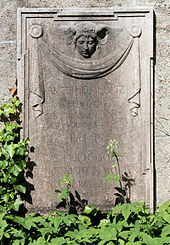Anna von Helmholtz

Anna (from 1883 von ) Helmholtz , born von Mohl, (born September 19, 1834 in Tübingen , † December 1, 1899 in Volosca , Istria ), was a Berlin salonnière during the imperial era and the wife of the physicist Hermann von Helmholtz .
Life

Anna von Helmholtz was the daughter of the Württemberg statesman Robert von Mohl (1799–1875) and his wife Pauline, née Becher (1808–1894). In 1852/53 she lived in Paris with her aunt, the Parisian Salonnière Mary Clarke Mohl , which was to have a lasting impact on her later life as a Salonnière.
After their wedding in 1861, she lived first in Heidelberg , then (from 1871) in Berlin . Since around 1872 - the year before her husband had been appointed to the Friedrich-Wilhelms-Universität - Anna von Helmholtz ran a salon in the capital of the young German Reich, at several different addresses , where the top of Berlin society met. Until his death in 1894, her husband Hermann, meanwhile a star of the scientific community of the empire, formed the center of the salon with her; but also as a widow she continued the tradition.
Anna's closer contact included Crown Princess Victoria , who later became Empress Friedrich, in whose commitment to nursing and education for girls she herself actively participated.
Anna von Helmholtz was also active in literature: she left an extensive letter and, together with Estelle du Bois-Reymond, the daughter of the famous physiologist Emil du Bois-Reymond , translated the text Modern Views of Electricity by the physicist Oliver Lodge ( Latest Views of Electricity . Leipzig 1896). Together with Clara Wiedemann , at the request of her spouses, she edited the translation of the books Heat as a mode of motion ( Warmth regarded as a kind of movement . Braunschweig, 4th edition 1894) and Sound: A Course of Eight Lectures ( Der Schall . Braunschweig , 3rd edition 1897) by the physicist John Tyndall .
In 1899 she died while on vacation in Istria . Her grave is in the Wannsee cemetery in Berlin.
family
Marriage and offspring
On May 16, 1861, Anna von Mohl married the physicist Hermann Helmholtz (1821–1894), who was ennobled in 1883. It was already the second marriage for Helmholtz.
The couple had three children:
- Robert von Helmholtz (1862-1889)
- Ellen von Helmholtz (1864–1941), ⚭ 1884 with Arnold von Siemens (1853–1918)
- Friedrich Julius von Helmholtz (1868–1901).
Famous relatives
Anna's uncles were
- the orientalist Julius Mohl (1800–1876),
- the economist Moritz Mohl (1802-1888) and
- the botanist Hugo von Mohl (1805–1872).
Her aunt was the Parisian Salonnière Mary Clarke-Mohl (1793-1883), wife of Julius Mohl.
Her brother was the diplomat Ottmar von Mohl (1846–1922).
salon
Social relevance
In the salons politicians met artists, writers met courtiers. The “Tuesdays” of Anna Helmholtz were particularly significant because they attracted a particularly large number of scholars, especially natural scientists. For the first time, the country's academic elite were offered a first-class social floor. As an interface between court society, the artistic scene and the educated bourgeoisie, her house became the most important salon in the young empire and the prototype of upper-class sociability in the late 19th century.
As the daughter of a lawyer who was ennobled because of his achievements and the wife of a scientist who also rose to the nobility through his own achievements, she embodied the ideal of the upper-class lady of her time, who harmoniously combines social polish and aristocratic treatment with artistic subtlety and serious scientific interest. Petra Wilhelmy describes her social role as follows:
“Despite her social position, her education and her significant social commitment, Anna von Helmholtz was not generally popular. They were admired and respected, but there was a distance. Marie von Bunsen […] suspected that she was resented for disregarding the model of the modest, reserved professor's wife as a 'grande dame' and highly educated salonnière. In fact, Anna von Helmholtz viewed her circles of the higher educated bourgeoisie as "intellectual aristocracy" and strived for top-class sociability at all costs. "
She was close friends with another great salonnière of the time, Countess Marie Schleinitz . Her two salons were the cornerstones of social life in Berlin: Mimi Schleinitz was mainly visited by artists, and Anna Helmholtz by scientists.
Known guests
The frequent guests ( habitués ) of the salon included:


Works
- Ellen v. Siemens-Helmholtz (Ed.): Anna von Helmholtz. A picture of life in letters . 2 volumes. Verlag für Kulturpolitik, Leipzig 1929.
literature
- Entry in the German Biographical Encyclopedia
- Petra Wilhelmy: The Berlin Salon in the 19th Century . Walter de Gruyter, Berlin a. a. 1989, pp. 283-290, 659-669.
- Franz Werner: Hermann Helmholtz 'Heidelberg Years (1858–1871) . Special publications of the Heidelberg City Archives, Vol. 8. Springer, Berlin / Heidelberg 1997. With 52 illustrations.
- Franz Werner: "May you be able to look forward to everything that is good, warm, heartfelt". A letter from the widow Anna von Helmholtz to the widow Cosima Wagner on Christmas Eve 1894 and the role of women at the end of the 19th century. In: Festschrift 175 years of the Helmholtz-Gymnasium Heidelberg. 1835-2010. Pp. 70-92.
Web links
- Literature by and about Anna von Helmholtz in the catalog of the German National Library
Individual evidence
| personal data | |
|---|---|
| SURNAME | Helmholtz, Anna von |
| ALTERNATIVE NAMES | Mohl, Anna von |
| BRIEF DESCRIPTION | Berlin Salonnière |
| DATE OF BIRTH | September 19, 1834 |
| PLACE OF BIRTH | Tübingen |
| DATE OF DEATH | December 1, 1899 |
| Place of death | Volosca near Opatija |
